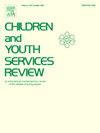The dynamic interplay between social status and children’s bullying network: A longitudinal social network analysis
IF 2.4
2区 社会学
Q1 FAMILY STUDIES
引用次数: 0
Abstract
Bullying is not only an individual behavior, but also a dynamic network that emerges through the complex process of changing ties between bullies and victims. Longitudinal research on bullying network and social status was limited. This study aimed to examine the social status of four types of bullying roles and the dynamic interplay between social status and bullying network. The study involved 965 students (52.1 % boys) from 22 fourth- and fifth-grade classes in China, spanning the years 2020 and 2021. To construct bullying networks and gauge social status, participants completed peer nomination questionnaires. Multi-level model and stochastic actor-oriented model were used to construct binary and ternary network effects. The results showed that bystanders emerged with the highest social status, while those occupying the bully/victim role had the lowest. Concerning social acceptance status, the ego effect was not significant (Est = −0.08, p > 0.05), but the alter effect was significant (Est = −0.19, p < 0.05). That is, children with high social preference trended to decrease bullying ties, yet their victimization ties will not significantly change. For social preference status, the ego effect was significant (Est = −0.21, p < 0.05), while the alter effect was not significant (Est = −0.04, p > 0.05). That is, children with high social acceptance trended to decrease victimization ties, but their bullying ties remain relatively unchanged. This study contributes to our understanding of bullying as a group process and the associations with social status, and provides implications for preventing school bullying.
社会地位与儿童欺凌网络的动态相互作用:一项纵向社会网络分析
欺凌不仅是一种个体行为,而且是一个动态的网络,它是通过欺凌者和受害者之间关系变化的复杂过程而出现的。欺凌网络与社会地位的纵向研究有限。本研究旨在探讨四种霸凌角色的社会地位,以及社会地位与霸凌网络的动态相互作用。该研究涉及来自中国22个四年级和五年级班级的965名学生(52.1%是男孩),时间跨度为2020年至2021年。为了构建霸凌网络和衡量社会地位,参与者完成了同伴提名问卷。采用多级模型和随机因子导向模型构建二元和三元网络效应。结果表明,旁观者的社会地位最高,而霸道/受害者的社会地位最低。在社会接受状态方面,自我效应不显著(Est = - 0.08, p >;0.05),但变异效应显著(Est = - 0.19, p <;0.05)。即,高社会偏好的儿童有减少欺凌联系的趋势,但其受害联系不会发生显著变化。对于社会偏好状态,自我效应显著(Est = - 0.21, p <;0.05),而变异效应不显著(Est = - 0.04, p >;0.05)。也就是说,社会接受度高的儿童的受害关系倾向于减少,但他们的欺凌关系保持相对不变。本研究有助于我们理解欺凌作为一个群体过程及其与社会地位的关系,并为预防校园欺凌提供启示。
本文章由计算机程序翻译,如有差异,请以英文原文为准。
求助全文
约1分钟内获得全文
求助全文
来源期刊

Children and Youth Services Review
Multiple-
CiteScore
6.30
自引率
6.10%
发文量
303
期刊介绍:
Children and Youth Services Review is an interdisciplinary forum for critical scholarship regarding service programs for children and youth. The journal will publish full-length articles, current research and policy notes, and book reviews.
 求助内容:
求助内容: 应助结果提醒方式:
应助结果提醒方式:


